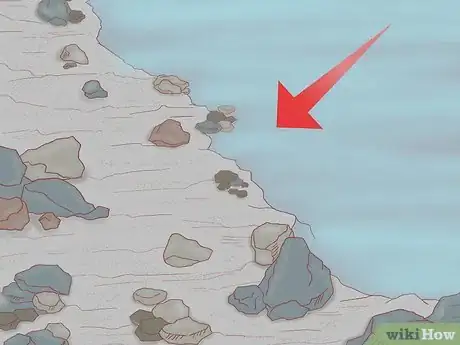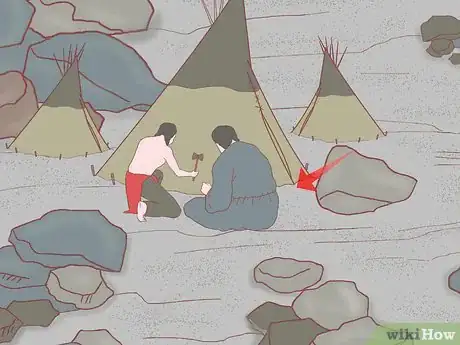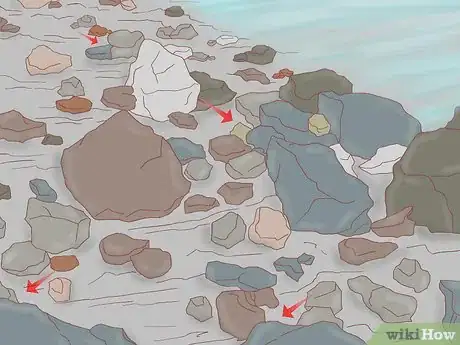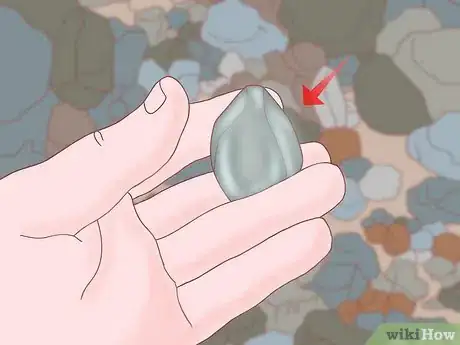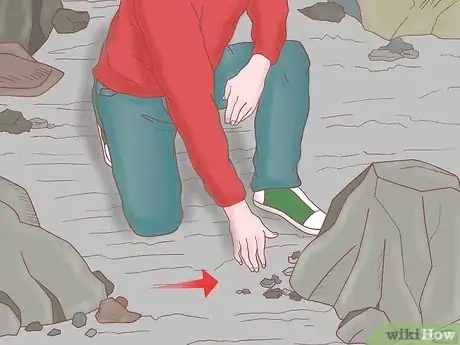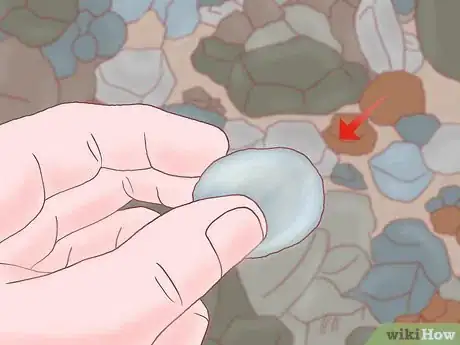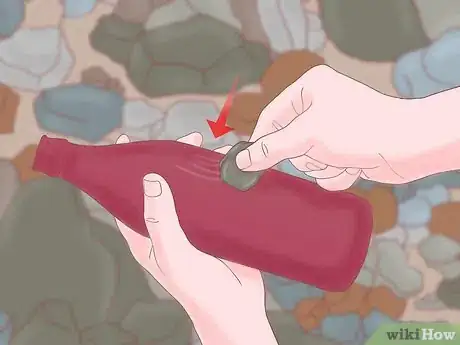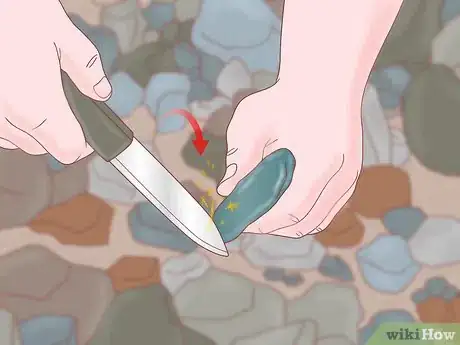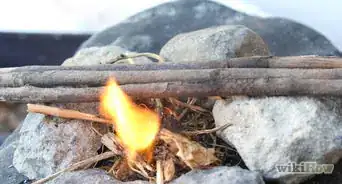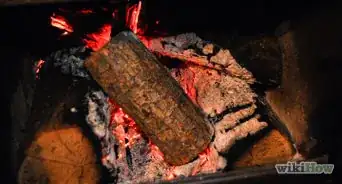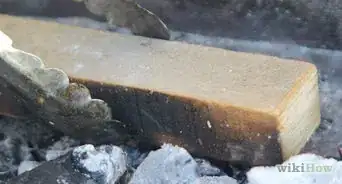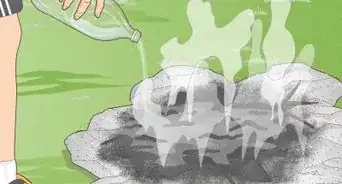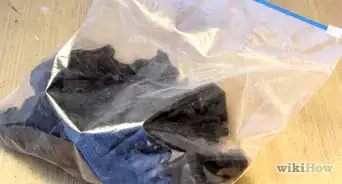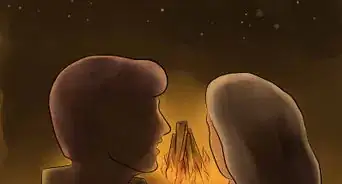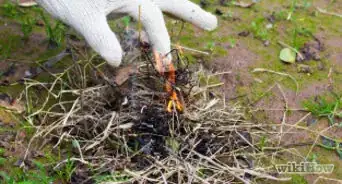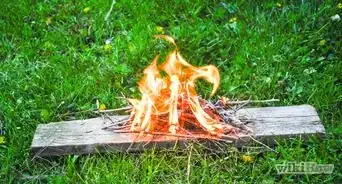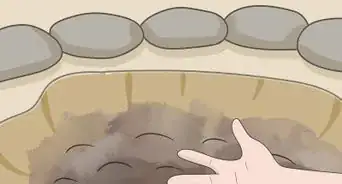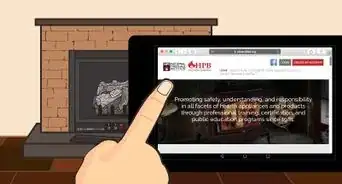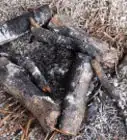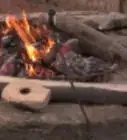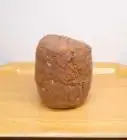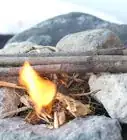This article was co-authored by Britt Edelen. Britt Edelen was an active member of his local Boy Scouts troop near Athens, Georgia from ages 8 to 16. As a Scout, he went on dozens of camping trips, learned and practiced many wilderness survival skills, and spent countless hours appreciating the great outdoors. In addition, Britt worked as a counselor for several summers at an adventure camp in his hometown, which allowed him to share his passion for and knowledge of the outdoors with others.
There are 10 references cited in this article, which can be found at the bottom of the page.
wikiHow marks an article as reader-approved once it receives enough positive feedback. This article received 15 testimonials and 86% of readers who voted found it helpful, earning it our reader-approved status.
This article has been viewed 466,198 times.
Flint, also known as chert, is a type of sedimentary rock that has many uses. It was once commonly used to form rudimentary tools like knives and spear tips. Flint is often used by outdoorsmen to create sparks for a fire when it is struck against hardened steel. Knowing how to find a piece of flint can come in handy when you're in the wild. Whether you're looking for artifacts or a way to start a fire, identifying flint isn't as hard as you think. But it only occurs where there was an ocean at one time. Chalk deposits are a dead giveaway to the existence of flint. You won't find flint in the North East U.S. But it is very common in the South East and Mid West. Quartz is a metamorphic rock and can be used like flint to start fires. Agate in the Mid West can also be used like flint.
Steps
Locating Flint
-
1Choose an area nearby to search. It might seem like flint is difficult to find, but you generally just need to know where to look. In some areas, like the Ozarks of Missouri, you can find chert lying all over the ground. That is because flint and chert are hard, durable rocks that are so resistant to weathering they remain intact long after the surrounding rocks have weathered away into the soil.
- You can search along the freshwater shores or riverbeds.[1] Flint is very durable and resistant to chemicals, so it often collects in the remaining soils as surrounding carbonate rocks erode.[2] While rocks like limestone erode and fine soil is carried downstream, small pebble deposits of flint and chert collect along the shores.
- Try other locations where there is a large variety of rocks present, such as a construction site or along a gravel road. Many times rocks are harvested from riverbeds for construction from all over so you might be surprised to find chert or flint pebbles just down the block.[3]
-
2Learn the history of your area. If you live near an area that was once populated by tribes of Native Americans, you might have a good chance of locating flint fragments around that area.
- Flint was an ideal choice for creating tools and weapons. Flint can be made to form a blade that is actually sharper than steel, with a tip that is just the width of a few molecules.[4] If you find an arrowhead or sharp rock near an old tribal ground, you found some flint.
Advertisement -
3Look for flint nodules in larger rocks. Flint often forms as nodules inside pieces of chalk or limestone.[5] So in addition to looking for pieces of flint, look for larger rocks that may contain several pieces of flint. Bust them open and see what you find.
- Look for discolorations on a piece of limestone. Usually flint or chert nodules will be a slightly darker shade than the surrounding limestone.[6] You can break these pieces out with the use of some tools and collect the flint.
- Grab an iron hammer and bust open some smaller rocks. If you notice some sparks when the hammer contacts the rock, there is likely some flint or quartz inside.
Spotting Flint Properties
-
1Notice the color of the rock. Flint will likely appear black or dark gray.[7] This is the only physical difference between flint and chert.[8] Chert doesn't have a particular identifying color, but it usually appears in a combination of a few different shades depending on the other minerals that are present. Shades of maroon, tan, yellow, white or occasionally a deep blue are all common among types of chert. Sometimes these colors may form bands along the surface.
-
2Look for flint in various shapes. Flint can be found in natural occurring nodules or as a fragment that has been worked into a shape.
- Flint nodules can appear in various smooth, rounded shapes embedded in chalk or limestone. When you find flint that has been embedded in a chalk bed, it is common to find an imprint of shells cast into the surface.[11]
- Look for rocks that have been split like broken glass. Flint fractures differently from many crystals. When the pieces come apart the tend to look like glass shards, with curves and sharper edges.[12]
- In addition to looking for natural nodules of flint, be sure to look for flint that has been worked into a shape. You can control the way flint splits easier than other rocks, which is another reason why people used to used flint to shape tools and weapons. Sometimes flint may have edges that seem to have been chipped away or have a point, indicating they have been used as a tool.
-
3Look for a glossy surface on the rock. Flint often displays a natural, glassy luster similar to pencil lead.[13] If it was just broken, the luster may seem dull and somewhat waxy to the touch. You can usually rub away or sand this cortex to reveal more of the surface luster.
-
4Test the hardness of the stone. If you have a glass bottle, try to scratch it with the sharp edge of the flint. If the rock is strong enough to scratch glass, it is as hard as flint.
- Be careful when striking glass with a rock. Using gloves to protect your hands is a good idea.
-
5Take out a striker made of carbon steel and strike it against the stone. If sparks fly after several attempts, then you might have a piece of flint.[14]
- The "sparks" produced are actually just the tiny fragments of iron breaking off the iron surface. The sudden exposure to air generates a rapid oxidization where the fragment can not dissipate the heat as fast as it generates it. The spark is only a glowing piece of freshly exposed iron.[15]
- If the rock doesn't have a very sharp edge, you will want to create one to test for sparks. To check the inside of a rock use a larger rock as a hammer to flake of pieces from the thinnest end of the rock.
- When striking your flint of metal, make sure the stone is dry, as a damp stone may not produce sparks.
- Other rocks, such as quartz, that have a hardness of seven on the Mohs Scale of Hardness will create sparks when struck against a carbon metal. If you are only looking for a rock which you can use to create sparks and start a fire, try learning what other rock types will also do the job.
Community Q&A
-
QuestionCan I make a fire from flint or stone sparks in a survival situation?
 Community AnswerYes you can, but you have to make sure the sparks hit the right spot or there will be no fire.
Community AnswerYes you can, but you have to make sure the sparks hit the right spot or there will be no fire. -
QuestionIs there flint in North Carolina?
 Community AnswerYes. Especially on beaches. You can also find flint on river banks or in streams.
Community AnswerYes. Especially on beaches. You can also find flint on river banks or in streams. -
QuestionIf I'm in Australia, where can I find flint?
 Connor CroninCommunity AnswerLook along beaches. You should be able to find some flint almost everywhere along the coast.
Connor CroninCommunity AnswerLook along beaches. You should be able to find some flint almost everywhere along the coast.
Warnings
- You may want to look for flints while wearing cloth or leather gloves. Your hands will easily become covered with dirt, and the sharp edges of stones or glass fragments may cut your hands.⧼thumbs_response⧽
References
- ↑ http://geology.com/rocks/flint.shtml
- ↑ http://www.britannica.com/science/chert
- ↑ http://www.flintknappingtools.com/where_flint.html
- ↑ http://survivaltopics.com/flint-and-steel-what-causes-the-sparks/
- ↑ http://geology.com/rocks/flint.shtml
- ↑ https://www.youtube.com/watch?v=hpN5UGAWfuM
- ↑ Britt Edelen. Boy Scout. Expert Interview. 7 February 2020.
- ↑ http://www.pitt.edu/~cejones/GeoImages/1Minerals/2SedimentaryMineralz/Quartz.html
- ↑ http://www.secretsofsurvival.com/survival/tinder-kindling-start-a-fire.html
- ↑ http://www.stoneagetools.co.uk/what-is-flint.htm
- ↑ http://www.stoneagetools.co.uk/what-is-flint.htm
- ↑ http://www.quartzpage.de/flint.html
- ↑ Britt Edelen. Boy Scout. Expert Interview. 7 February 2020.
- ↑ Britt Edelen. Boy Scout. Expert Interview. 7 February 2020.
- ↑ http://survivaltopics.com/flint-and-steel-what-causes-the-sparks/
About This Article
To identify flint, look for rocks that are black or dark gray in color. Flint may be smooth or rounded, especially if it’s embedded in chalk or limestone, but it can also be split so that it looks like broken shards of glass. If you think you’ve found a piece of flint, strike a piece of carbon steel against the stone. It may take a few attempts, but if you see sparks, then the rock is flint! For tips on where to look for flint, read on!
